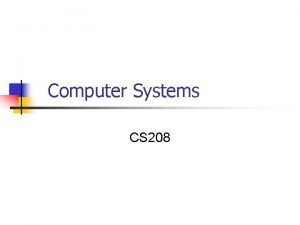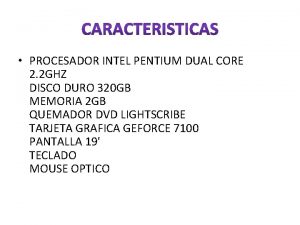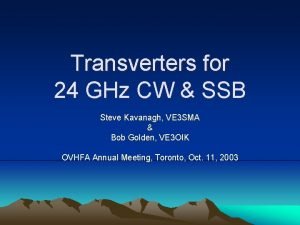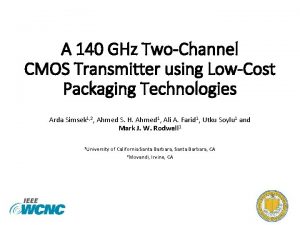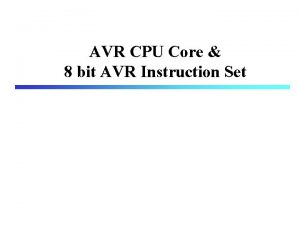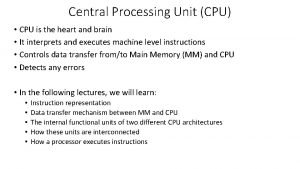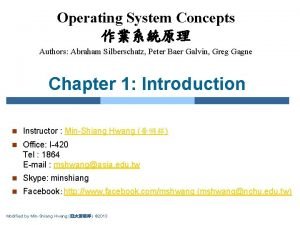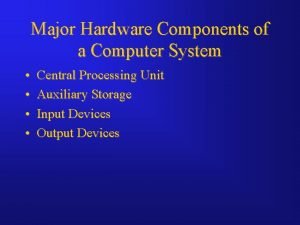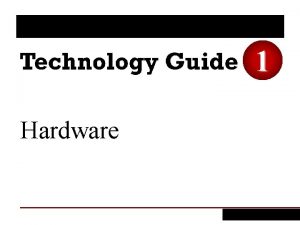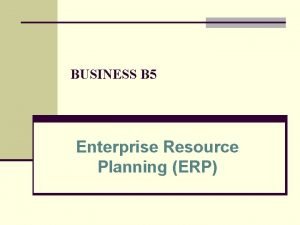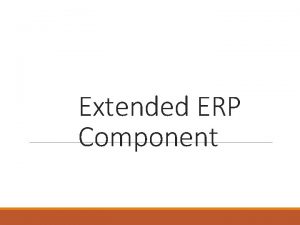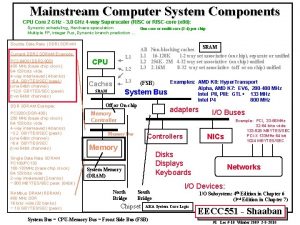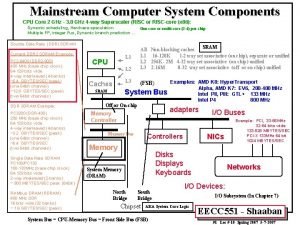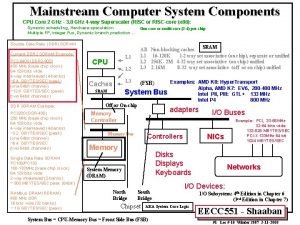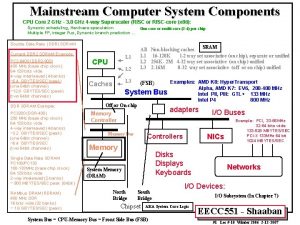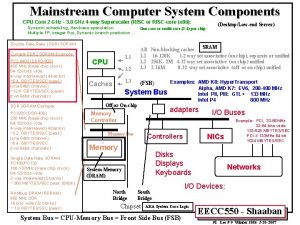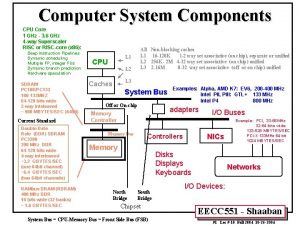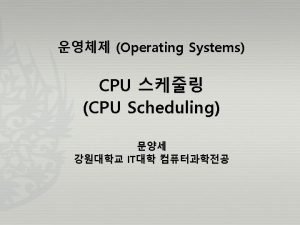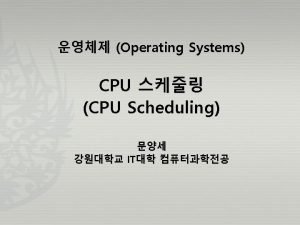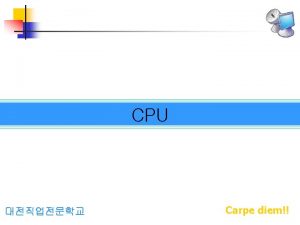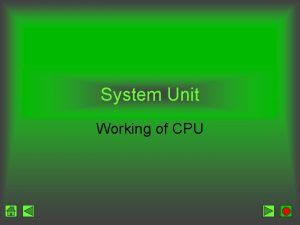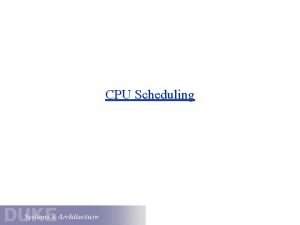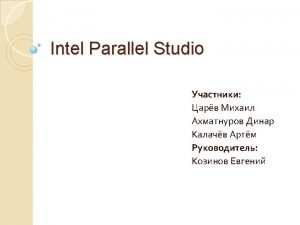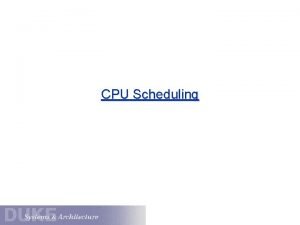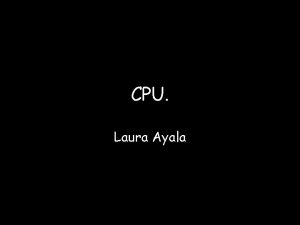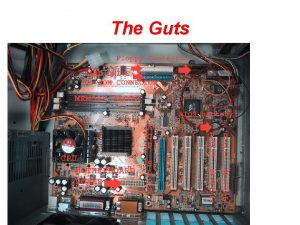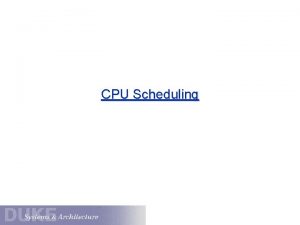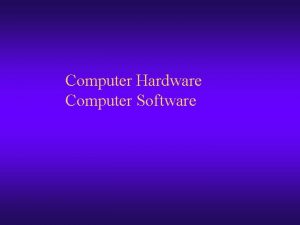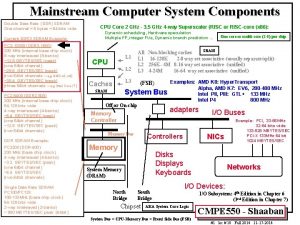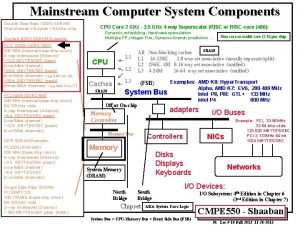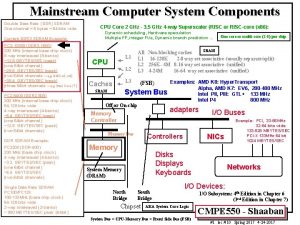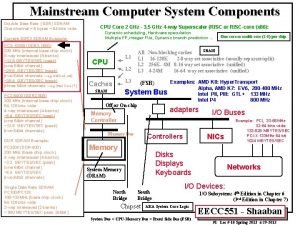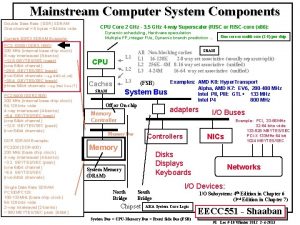Mainstream Computer System Components CPU Core 1 GHz































- Slides: 31

Mainstream Computer System Components CPU Core 1 GHz - 3. 8 GHz 4 -way Superscaler RISC or RISC-core (x 86): Deep Instruction Pipelines Dynamic scheduling Multiple FP, integer FUs Dynamic branch prediction Hardware speculation SDRAM PC 100/PC 133 100 -133 MHZ 64 -128 bits wide 2 -way inteleaved ~ 900 MBYTES/SEC )64 bit) Current Standard Double Date Rate (DDR) SDRAM PC 3200 MHz DDR 64 -128 bits wide 4 -way interleaved ~3. 2 GBYTES/SEC (one 64 bit channel) ~6. 4 GBYTES/SEC (two 64 bit channels) RAMbus DRAM (RDRAM) 400 MHz DDR 16 bits wide (32 banks) ~ 1. 6 GBYTES/SEC L 2 SRAM All Non-blocking caches L 1 16 -128 K 1 -2 way set associative (on chip), separate or unified L 2 256 K- 2 M 4 -32 way set associative (on chip) unified L 3 2 -16 M 8 -32 way set associative (off or on chip) unified L 3 (FSB) L 1 CPU Caches System Bus Off or On-chip adapters Memory Controller Memory Bus I/O Buses NICs Controllers Memory Disks Displays Keyboards System Memory (DRAM) North Bridge Examples: Alpha, AMD K 7: EV 6, 200 -400 MHz Intel PII, PIII: GTL+ 133 MHz Intel P 4 800 MHz South Bridge Chipset System Bus = CPU-Memory Bus = Front Side Bus (FSB) Example: PCI, 33 -66 MHz 32 -64 bits wide 133 -528 MBYTES/SEC PCI-X 133 MHz 64 bit 1024 MBYTES/SEC Networks I/O Devices: I/O Subsystem (In Chapter 7) EECC 551 - Shaaban #1 Lec # 10 Spring 2006 5 -8 -2006

The Memory Hierarchy • Review of Memory Hierarchy & Cache Basics (from 550) – – • Cache Basics: CPU Performance Evaluation with Cache Classification of Steady-State Cache Misses: – The Three C’s of cache Misses • • • Cache Write Policies/Performance Evaluation Cache Write Miss Policies Multi-Level Caches & Performance • Main Memory: – Performance Metrics: Latency & Bandwidth Cache exploits access locality to: • Lower AMAT by hiding long main memory access latency. • Lower demands on main memory bandwidth. (In Chapter 5. 8 - 5. 10) • Key DRAM Timing Parameters – DRAM System Memory Generations – Basic Memory Bandwidth Improvement/Miss Penalty Reduction Techniques • Techniques To Improve Cache Performance: • Virtual Memory • Reduce Miss Rate • Reduce Cache Miss Penalty • Reduce Cache Hit Time i. e Memory latency reduction • Benefits, Issues/Strategies • Basic Virtual ® Physical Address Translation: Page Tables • Speeding Up Address Translation: Translation Lookaside Buffer (TLB) EECC 551 - Shaaban #2 Lec # 10 Spring 2006 5 -8 -2006

Main Memory • • • Main memory generally utilizes Dynamic RAM (DRAM), which use a single transistor to store a bit, but require a periodic data refresh by reading every row increasing cycle time. DRAM: Slow but high density Static RAM may be used for main memory if the added expense, low density, high power consumption, and complexity is feasible (e. g. Cray Vector Supercomputers). Main memory performance is affected by: SRAM: Fast but low density – Memory latency: Affects cache miss penalty, M. Measured by: • Memory Access time: The time it takes between a memory access request is issued to main memory and the time the requested information is available to cache/CPU. • Memory Cycle time: The minimum time between requests to memory (greater than access time in DRAM to allow address lines to be stable) – Peak Memory bandwidth: The maximum sustained data transfer rate between main memory and cache/CPU. • In current memory technologies (e. g Double Data Rate SDRAM) published peak memory bandwidth does not take account most of the memory access latency. • This leads to achievable realistic memory bandwidth < peak memory bandwidth (In Chapter 5. 8 - 5. 10) Or effective memory bandwidth EECC 551 - Shaaban #3 Lec # 10 Spring 2006 5 -8 -2006

Logical Dynamic RAM (DRAM) Chip Organization (16 Mbit) Column Decoder … Sense Amps & I/O 14 Data In Row Decoder Row/Column Address A 0…A 13 0 D Memory Array Shared Pins Q (16, 384 x 16, 384) Data Out D, Q share the same pins Word Line Basic Steps: Control Signals: 1 - Row Access Strobe (RAS): Low to latch row address 2 - Column Address Strobe (CAS): Low to latch column address 3 - Write Enable (WE) or Output Enable (OE) 4 - Wait for data to be ready 1 - Supply Row Address 2 - Supply Column Address 3 - Get Data Storage Cell (Single transistor per bit) A periodic data refresh is required by reading every bit EECC 551 - Shaaban #4 Lec # 10 Spring 2006 5 -8 -2006

Four Key DRAM Timing Parameters 1 • t. RAC: Minimum time from RAS (Row Access Strobe) line falling (activated) to the valid data output. – Used to be quoted as the nominal speed of a DRAM chip – For a typical 64 Mb DRAM t. RAC = 60 ns 2 • t. RC: Minimum time from the start of one row access to the start of the next (memory cycle time). – t. RC = t. RAC + RAS Precharge Time – t. RC = 110 ns for a 64 Mbit DRAM with a t. RAC of 60 ns 3 • t. CAC: Minimum time from CAS (Column Access Strobe) line falling to valid data output. – 12 ns for a 64 Mbit DRAM with a t. RAC of 60 ns 4 • t. PC: Minimum time from the start of one column access to the start of the next. – t. PC = t. CAC + CAS Precharge Time – About 25 ns for a 64 Mbit DRAM with a t. RAC of 60 ns 1 - Supply Row Address 2 - Supply Column Address 3 - Get Data EECC 551 - Shaaban #5 Lec # 10 Spring 2006 5 -8 -2006

Simplified Asynchronous DRAM Read Timing Memory Cycle Time = t. RC = t. RAC + RAS Precharge Time 2 t. RC (late 70 s) (memory cycle time) t. PC 4 1 (memory access time) 3 1 2 3 4 t. RAC: Minimum time from RAS (Row Access Strobe) line falling to the valid data output. t. RC: Minimum time from the start of one row access to the start of the next (memory cycle time). t. CAC: minimum time from CAS (Column Access Strobe) line falling to valid data output. t. PC: minimum time from the start of one column access to the start of the next. Peak Memory Bandwidth = Memory bus width / Memory cycle time Example: Memory Bus Width = 8 Bytes Memory Cycle time = 200 ns Peak Memory Bandwidth = 8 / 200 x 10 -9 = 40 x 106 Bytes/sec Source: http: //arstechnica. com/paedia/r/ram_guide. part 2 -1. html EECC 551 - Shaaban #6 Lec # 10 Spring 2006 5 -8 -2006

Simplified DRAM Speed Parameters • Row Access Strobe (RAS)Time: (similar to t. RAC): – Minimum time from RAS (Row Access Strobe) line falling (activated) to the first valid data output. – A major component of memory latency. – Only improves ~ 5% every year. • Column Access Strobe (CAS) Time/data transfer time: (similar to t. CAC) – The minimum time required to read additional data by changing column address while keeping the same row address. – Along with memory bus width, determines peak memory bandwidth. • E. g For SDRAM Peak Memory Bandwidth = Bus Width /(0. 5 x t. CAC) For PC 100 SDRAM Memory bus width = 8 bytes t. CAC = 20 ns Peak Bandwidth = 8 x 100 x 106 = 800 x 106 bytes/sec EECC 551 - Shaaban #7 Lec # 10 Spring 2006 5 -8 -2006

DRAM Generations Size 1980 1983 1986 1989 1992 1996 1998 2000 2002 64 Kb 256 Kb 1 Mb 4 Mb 16 Mb 64 Mb 128 Mb 256 Mb 512 Mb RAS (ns) CAS (ns) 150 -180 120 -150 100 -120 80 -100 60 -80 50 -70 45 -65 40 -60 75 50 25 20 15 12 10 7 5 8000: 1 (Capacity) 15: 1 (~bandwidth) Cycle Time 250 ns 220 ns 190 ns 165 ns 120 ns 110 ns 100 ns 90 ns 80 ns Memory Type Page Mode Fast Page Mode EDO PC 66 SDRAM PC 100 SDRAM PC 133 SDRAM PC 2700 DDR SDRAM 3: 1 (Latency) PC 3200 DDR (2003) DDR 2 SDRAM (2004) A major factor in cache miss penalty M EECC 551 - Shaaban #8 Lec # 10 Spring 2006 5 -8 -2006 Asynchronous DRAM Synchronous DRAM Year

Asynchronous DRAM: Page Mode DRAM (Early 80 s) Memory Cycle Time EECC 551 - Shaaban #9 Lec # 10 Spring 2006 5 -8 -2006

Fast Page Mode DRAM (late 80 s) (FPM) (Change) (constant for entire burst access) • The first “burst mode” DRAM (memory access time) A read burst of length 4 shown 1 2 3 4 Burst Mode Memory Access EECC 551 - Shaaban #10 Lec # 10 Spring 2006 5 -8 -2006

Simplified Asynchronous Fast Page Mode (FPM) DRAM Read Timing (late 80 s) FPM DRAM speed rated using t. RAC ~ 50 -70 ns t. PC (memory access time) First 8 bytes Second 8 bytes etc. A read burst of length 4 shown Typical timing at 66 MHz : 5 -3 -3 -3 (burst of length 4) For bus width = 64 bits = 8 bytes cache block size = 32 bytes It takes = 5+3+3+3 = 14 memory cycles or 15 ns x 14 = 210 ns to read 32 byte block Miss penalty for CPU running at 1 GHz = M = 15 x 14 = 210 CPU cycles One memory cycle at 66 MHz = 1000/66 = 15 CPU cycles at 1 GHz 1 2 3 4 EECC 551 - Shaaban #11 Lec # 10 Spring 2006 5 -8 -2006

Simplified Asynchronous Extended Data Out (EDO) DRAM Read Timing • Extended Data Out DRAM operates in a similar fashion to Fast Page Mode DRAM except putting data from one read on the output pins at the same time the column address for the next read is being latched in. EDO DRAM speed rated using t. RAC ~ 40 -60 ns (memory access time) (early 90 s) Typical timing at 66 MHz : 5 -2 -2 -2 (burst of length 4) For bus width = 64 bits = 8 bytes Max. Bandwidth = 8 x 66 / 2 = 264 Mbytes/sec It takes = 5+2+2+2 = 11 memory cycles or 15 ns x 11 = 165 ns to read 32 byte cache block Minimum Read Miss penalty for CPU running at 1 GHz = M = 11 x 15 = 165 CPU cycles One memory cycle at 66 MHz = 1000/66 = 15 CPU cycles at 1 GHz Source: http: //arstechnica. com/paedia/r/ram_guide. part 2 -1. html EECC 551 - Shaaban #12 Lec # 10 Spring 2006 5 -8 -2006

Basic Memory Bandwidth Improvement/Miss Penalty (M) Latency Improvement/ Reduction Techniques • Wider Main Memory (CPU-Memory Bus): Memory bus width is increased to a number of words (usually up to the size of a cache block). – Memory bandwidth is proportional to memory bus width. • e. g Doubling the width of cache and memory doubles potential memory bandwidth available to the CPU. – The miss penalty is reduced since fewer memory bus accesses are needed to fill a cache block on a miss. • Interleaved (Multi-Bank) Memory: Memory is organized as a number of independent banks. – Multiple interleaved memory reads or writes are accomplished by sending memory addresses to several memory banks at once or pipeline access to the banks. – Interleaving factor: Refers to the mapping of memory addressees to memory banks. Goal reduce bank conflicts. e. g. using 4 banks (width one word), bank 0 has all words whose address is: (word address mod) 4 = 0 EECC 551 - Shaaban #13 Lec # 10 Spring 2006 5 -8 -2006

Wider memory, bus and cache (highest performance) (FSB) Narrow bus and cache with interleaved memory banks (FSB) Three examples of bus width, memory width, and memory interleaving to achieve higher memory bandwidth Simplest design: Everything is the width of one word (lowest performance) Front Side Bus (FSB) = System Bus = CPU-memory Bus EECC 551 - Shaaban #14 Lec # 10 Spring 2006 5 -8 -2006

Four Way (Four Banks) Interleaved Memory Bank Number Address Within Bank 0 Bank 1 Bank 2 Bank 3 0 4 8 12 16 20. . 1 5 9 13 17 21. . 2 6 10 14 18 22. . 3 7 11 15 19 23. . Bank Width = One Word Bank Number = (Word Address) Mod (4) EECC 551 - Shaaban #15 Lec # 10 Spring 2006 5 -8 -2006

Memory Bank Interleaving Can be applied at: 1 - DRAM chip level (e. g SDRAM, DDR) 2 - DRAM module level 3 - DRAM channel level (One Memory Bank) Memory Bank Cycle Time Very long memory bank recovery time shown here (4 banks similar to the organization of DDR SDRAM memory chips) Pipeline access to different memory banks to increase effective bandwidth Memory Bank Cycle Time Number of banks ³ Number of cycles to access word in a bank Bank interleaving does not reduce latency of accesses to the same bank EECC 551 - Shaaban #16 Lec # 10 Spring 2006 5 -8 -2006

Synchronous DRAM Characteristics Summary Peak Bandwidth (Latency not taken into account) SDRAM DDR (Double Data Rate) SDRAM RAMbus (Mid 2004) . 1 x 8 =. 8 . 133 x 2 x 8 = 2. 1 (Similar to PC 3200). 2 x 2 x 8 = 3. 2 . 4 x 2 = 1. 6 DRAM Clock Rate # of Banks per DRAM Chip 2 4 4 32 Bus Width Bytes 8 8 8 2 The latencies given only account for memory module latency and do not include memory controller latency or other address/data line delays. Thus realistic access latency is longer EECC 551 - Shaaban #17 Lec # 10 Spring 2006 5 -8 -2006

SDRAM Peak Memory Bandwidth = = Bus Width /(0. 5 x t. CAC) = Bus Width x Clock rate (Data Lines) Synchronous Dynamic RAM, (SDRAM) Organization (mid 90 s) A SDRAM speed is rated at max. clock speed supported: 100 MHZ = PC 100 133 MHZ = PC 133 DDR SDRAM (late 90 s - current) organization is similar but four banks are used in each DDR SDRAM chip instead of two. Address Lines Data transfer on both rising and falling edges of the clock DDR SDRAM rated by maximum or peak memory bandwidth PC 3200 = 8 bytes x 200 MHz x 2 = 3200 Mbytes/sec DDR SDRAM Peak Memory Bandwidth = = Bus Width /(0. 25 x t. CAC) = Bus Width x Clock rate x 2 1 1 2 2 3 3 4 4 5 SDRAM 6 7 DDR SDRAM Timing Comparison EECC 551 - Shaaban #18 Lec # 10 Spring 2006 5 -8 -2006

Simplified SDRAM/DDR SDRAM Read Timing SDRAM clock cycle time ~ ½ t. CAC Twice as fast as SDRAM? DDR SDRAM: Possible timing at 133 MHz (DDR x 2) (PC 2100 DDR SDRAM) : 5 -. 5 -. 5 For bus width = 64 bits = 8 bytes Max. Bandwidth = 133 x 2 x 8 = 2128 Mbytes/sec It takes = 5+. 5 = 6. 5 memory cycles or 7. 5 ns x 8 = 45 ns to read 32 byte cache block Minimum Read Miss penalty for CPU running at 1 GHz = M = 7. 5 x 6 = 49 CPU cycles (DDR SDRAM Max. Burst Length = 16) Latency (memory access time) Data Data DDR SDRAM (Late 90 s-Now) (SDRAM Max. Burst Length = 8) SDRAM (mid 90 s) SDRAM Typical timing at 133 MHz (PC 133 SDRAM) : 5 -1 -1 -1 For bus width = 64 bits = 8 bytes Max. Bandwidth = 133 x 8 = 1064 Mbytes/sec It takes = 5+1+1+1 = 8 memory cycles or 7. 5 ns x 8 = 60 ns to read 32 byte cache block Minimum Read Miss penalty for CPU running at 1 GHz = M = 7. 5 x 8 = 60 CPU cycles In this example for SDRAM: M = 60 cycles for DDR SDRAM: M = 49 cycles Thus accounting for access latency DDR is 60/49 = 1. 22 times faster Not twice as fast (2128/1064 = 2) as indicated by peak bandwidth! EECC 551 - Shaaban #19 Lec # 10 Spring 2006 5 -8 -2006

The Impact of Larger Cache Block Size on Miss Rate A larger cache block size improves cache performance by taking better advantage of spatial locality However, for a fixed cache size, larger block sizes mean fewer cache block frames • • • Performance keeps improving to a limit when the fewer number of cache block frames increases conflicts and thus overall cache miss rate Improves spatial locality reducing compulsory misses For SPEC 92 X EECC 551 - Shaaban #20 Lec # 10 Spring 2006 5 -8 -2006

Memory Width, Interleaving: Performance Example Given the following system parameters with single unified cache level L 1 (ignoring write policy): Block size= 1 word Memory bus width= 1 word Miss rate =3% M = Miss penalty = 32 cycles (4 cycles to send address 24 cycles access time, 4 cycles to send a word to CPU) 4 cycles 24 cycles Miss Penalty = M= 4 + 24 + 4 = 32 cycles (Base system) Memory access/instruction = 1. 2 CPIexecution (ignoring cache misses) = 2 Miss rate (block size = 2 word = 8 bytes ) = 2% Miss rate (block size = 4 words = 16 bytes) = 1% • The CPI of the base machine with 1 -word blocks = 2 + (1. 2 x 0. 03 x 32) = 3. 15 Increasing the block size to two words (64 bits) gives the following CPI: • • • 32 -bit bus and memory, no interleaving, M = 2 x 32 = 64 cycles 32 -bit bus and memory, interleaved, M = 4 + 24 + 8 = 36 cycles 64 -bit bus and memory, no interleaving, M = 32 cycles (miss rate = 2%) CPI = 2 + (1. 2 x. 02 x 64) = 3. 54 CPI = 2 + (1. 2 x. 02 x 36) = 2. 86 CPI = 2 + (1. 2 x 0. 02 x 32) = 2. 77 Increasing the block size to four words (128 bits); resulting CPI: • • • (For Base system) (miss rate = 1%) 32 -bit bus and memory, no interleaving , M = 4 x 32 = 128 cycles CPI = 2 + (1. 2 x 0. 01 x 128) = 3. 54 32 -bit bus and memory, interleaved , M = 4 + 24 + 16 = 44 cycles CPI = 2 + (1. 2 x 0. 01 x 44) = 2. 53 64 -bit bus and memory, no interleaving, M = 2 x 32 = 64 cycles CPI = 2 + (1. 2 x 0. 01 x 64) = 2. 77 64 -bit bus and memory, interleaved, M = 4 + 24 + 8 = 36 cycles CPI = 2 + (1. 2 x 0. 01 x 36) = 2. 43 128 -bit bus and memory, no interleaving, M = 32 cycles CPI = 2 + (1. 2 x 0. 01 x 32) = 2. 38 4 24 4 4 Miss Penalty = M = Number of CPU stall cycles for an access missed in cache and satisfied by main memory EECC 551 - Shaaban #21 Lec # 10 Spring 2006 5 -8 -2006

Three-Level Cache Example • • • All Unified CPU with CPIexecution = 1. 1 running at clock rate = 500 MHz Ignoring write policy 1. 3 memory accesses per instruction. L 1 cache operates at 500 MHz (no stalls on a hit in L 1) with a miss rate of 5% L 2 hit access time = 3 cycles (T 2= 2 stall cycles per hit), local miss rate 40% L 3 hit access time = 6 cycles (T 3= 5 stall cycles per hit), local miss rate 50%, Memory access penalty, M= 100 cycles (stall cycles per access). Find CPI. With No Cache, With single L 1, CPI = 1. 1 + 1. 3 x 100 = 131. 1 CPI = 1. 1 + 1. 3 x. 05 x 100 = 7. 6 With L 1, L 2 CPI = 1. 1 + 1. 3 x (. 05 x. 6 x 2 +. 05 x. 4 x 100) = 3. 778 CPI = CPIexecution + Mem Stall cycles per instruction = Mem accesses per instruction x Stall cycles per access Stall cycles per memory access = (1 -H 1) x H 2 x T 2 + (1 -H 1) x (1 -H 2) x H 3 x T 3 + (1 -H 1)(1 -H 2) (1 -H 3)x M =. 05 x. 6 x 2 +. 05 x. 4 x. 5 x 5 +. 05 x. 4 x. 5 x 100 =. 06 +. 05 + 1 = 1. 11 AMAT = 1. 11 + 1 = 2. 11 cycles (vs. AMAT = 3. 06 with L 1, L 2, vs. 5 with L 1 only) CPI = 1. 1 + 1. 3 x 1. 11 = 2. 54 Speedup compared to L 1 only = 7. 6/2. 54 = 3 Speedup compared to L 1, L 2 = 3. 778/2. 54 = 1. 49 Repeated here from lecture 8 EECC 551 - Shaaban #22 Lec # 10 Spring 2006 5 -8 -2006

3 -Level (All Unified) Cache Performance Memory Access Tree (Ignoring Write Policy) CPU Stall Cycles Per Memory Access = CPI + (1 + fraction of loads and stores) x stalls per access CPU Memory Access (100%) CPI = 1. 1 + 1. 3 x 1. 11 = 2. 54 execution H 1 =. 95 or 95% L 1 Hit: L 1 L 2 Hit Access Time = 1 Stalls Per access = 0 Stalls= H 1 x 0 = 0 ( No Stall) L 1 Miss: % = (1 -H 1) =. 05 or 5% (1 -H 1) x H 2 =. 05 x. 6 =. 03 or 3% T 1 = 0 cycles T 2 = 2 cycles T 3 = 5 cycles M = 100 cycles L 1 Miss, L 2 Hit: Hit Access Time =T 2 +1 = 3 Stalls per L 2 Hit = T 2 =2 Stalls =(1 -H 1) x H 2 x T 2 =. 05 x. 6 x 2 =. 06 L 3 H 1 = 95% H 2 = 60% H 3 = 50% Stalls on a hit L 1 Miss, L 2 Miss: % = (1 -H 1)(1 -H 2) =. 05 x. 4 =. 02 or 2% (1 -H 1) x (1 -H 2) x H 3 =. 05 x. 4 x. 5 =. 01 or 1% L 1 Miss, L 2 Miss, L 3 Hit: Hit Access Time =T 3 +1 = 6 Stalls per L 2 Hit = T 3 = 5 Stalls = (1 -H 1) x (1 -H 2) x H 3 x T 3 =. 01 x 5 =. 05 cycles (1 -H 1)(1 -H 2)(1 -H 3) =. 05 x. 4 x. 5 =. 01 or 1% L 1 Miss, L 2, Miss, L 3 Miss: Miss Penalty = M = 100 Stalls = (1 -H 1)(1 -H 2)(1 -H 3) x M =. 01 x 100 = 1 cycle Stall cycles per memory access = (1 -H 1) x H 2 x T 2 + (1 -H 1) x (1 -H 2) x H 3 x T 3 + (1 -H 1)(1 -H 2) (1 -H 3)x M =. 06 +. 05 +1 = 1. 11 AMAT = 1 + Stall cycles per memory access = 1 + 1. 11 = 2. 11 cycles T 2 = 2 cycles = Stalls per hit access for Level 2 T 3 = 5 cycles = Stalls per hit access for Level 3 M= Memory Miss Penalty = M = 100 cycles Repeated here from lecture 8 EECC 551 - Shaaban #23 Lec # 10 Spring 2006 5 -8 -2006

Program Steady-State Bandwidth-Usage Example • • In the previous example with three levels of cache (all unified, ignore write policy) CPU with CPIexecution = 1. 1 running at clock rate = 500 MHz 1. 3 memory accesses per instruction. L 1 cache operates at 500 MHz (no stalls on a hit in L 1) with a miss rate of 5% L 2 hit access time = 3 cycles (T 2= 2 stall cycles per hit), local miss rate 40% L 3 hit access time = 6 cycles (T 3= 5 stall cycles per hit), local miss rate 50%, Memory access penalty, M= 100 cycles (stall cycles per access to deliver 32 bytes from main memory to CPU) We found the CPI: With No Cache, CPI = 1. 1 + 1. 3 x 100 = 131. 1 With single L 1, CPI = 1. 1 + 1. 3 x. 05 x 100 = 7. 6 With L 1, L 2 CPI = 1. 1 + 1. 3 x (. 05 x. 6 x 2 +. 05 x. 4 x 100) = 3. 778 With L 1, L 2 , L 3 CPI = 1. 1 + 1. 3 x 1. 11 = 2. 54 Assuming that all cache blocks are 32 bytes For each of the three cases with cache: A. What is the peak (or maximum) number of memory accesses and effective peak bandwidth for each cache level and main memory? B. What is the total number of memory accesses generated by the CPU per second? C. What percentage of these memory accesses reach cache level/memory and what percentage of each cache level/memory bandwidth is used by the CPU? EECC 551 - Shaaban #24 Lec # 10 Spring 2006 5 -8 -2006

Program Steady-State Bandwidth-Usage Example A. What is the peak (or maximum) number of memory accesses and effective peak bandwidth for each cache level and main memory? • L 1 cache requires 1 CPU cycle to deliver 32 bytes, thus: Maximum L 1 accesses per second = 500 x 106 accesses/second Maximum effective L 1 bandwidth = 32 x 500 x 106 = 16, 000 x 106 = 16 x 109 byes/sec • L 2 cache requires 3 CPU cycles to deliver 32 bytes, thus: Maximum L 2 accesses per second = 500/3 x 106 = 166. 67 x 106 accesses/second Maximum effective L 2 bandwidth = 32 x 166. 67 x 106 = 5, 333. 33 x 106 = 5. 33 x 109 byes/sec • L 3 cache requires 6 CPU cycles to deliver 32 bytes, thus: Maximum L 3 accesses per second = 500/6 x 106 = 83. 33 x 106 accesses/second Maximum effective L 3 bandwidth = 32 x 166. 67 x 106 = 2, 666. 67 x 106 = 2. 67 x 109 byes/sec • Memory requires 101 CPU cycles ( 101= M+1 = 100+1) to deliver 32 bytes, thus: Maximum main memory accesses per second = 500/101 x 106 = 4. 95 x 106 accesses/second Maximum effective main memory bandwidth = 32 x 4. 95 x 106 = 158. 42 x 106 byes/sec EECC 551 - Shaaban #25 Lec # 10 Spring 2006 5 -8 -2006

Program Steady-State Bandwidth-Usage Example • For CPU with L 1 Cache: B. What is the total number of memory accesses generated by the CPU per second? • • The total number of memory accesses generated by the CPU per second = (memory access/instruction) x clock rate / CPI = 1. 3 x 500 x 106 / CPI = 650 x 106 / CPI With single L 1 cache CPI was found = 7. 6 – CPU memory accesses = 650 x 106 / 7. 6 = 85 x 106 accesses/sec C. What percentage of these memory accesses reach cache level/memory and what percentage of each cache level/memory bandwidth is used by the CPU? • For L 1: The percentage of CPU memory accesses that reach L 1 = 100% L 1 Cache bandwidth usage = 32 x 85 x 106 = 2, 720 x 106 = 2. 7 x 109 byes/sec Percentage of L 1 bandwidth used = 2, 720 / 16, 000 = 0. 17 or 17% (or • by just dividing CPU accesses / peak L 1 accesses = 85/500 = 0. 17 = 17%) For Main Memory: The percentage of CPU memory accesses that reach main memory = (1 -H 1) = 0. 05 or 5% Main memory bandwidth usage = 0. 05 x 32 x 85 x 106 = 136 x 106 byes/sec Percentage of main memory bandwidth used = 136 / 158. 42 = 0. 8585 or 85. 85% EECC 551 - Shaaban #26 Lec # 10 Spring 2006 5 -8 -2006

Program Steady-State Bandwidth-Usage Example • B. For CPU with L 1, L 2 Cache: What is the total number of memory accesses generated by the CPU per second? • The total number of memory accesses generated by the CPU per second = (memory access/instruction) x clock rate / CPI = 1. 3 x 500 x 106 / CPI = 650 x 106 / CPI With L 1, L 2 cache CPI was found = 3. 778 – CPU memory accesses = 650 x 106 / 3. 778 = 172 x 106 accesses/sec Vs. With L 1 only = 85 • x 106 accesses/sec C. What percentage of these memory accesses reach cache level/memory and what percentage of each cache level/memory bandwidth is used by the CPU? • For L 1: The percentage of CPU memory accesses that reach L 1 = 100% L 1 Cache bandwidth usage = 32 x 172 x 106 = 5, 505 x 106 = 5. 505 x 109 byes/sec Percentage of L 1 bandwidth used = 5, 505 / 16, 000 = 0. 344 or 34. 4% Vs. With L 1 only = 17% (or by just dividing CPU accesses / peak L 1 accesses = 172/500 = 0. 344 = 34. 4%) • For L 2: The percentage of CPU memory accesses that reach L 2 = (I-H 1) = 0. 05 or 5% L 2 Cache bandwidth usage = 0. 05 x 32 x 172 x 106 = 275. 28 x 106 byes/sec Percentage of L 2 bandwidth used = 275. 28 / 5, 333. 33 = 0. 0516 or 5. 16% (or by just dividing CPU accesses that reach L 2 / peak L 2 accesses = 0. 05 x 172/ /166. 67 = 8. 6/ 166. 67= 0. 0516= 5. 16%) • For Main Memory: The percentage of CPU memory accesses that reach main memory = (1 -H 1) x (1 -H 2) = 0. 05 x 0. 4 = 0. 02 or 2% Main memory bandwidth usage = 0. 02 x 32 x 172 x 106 = 110. 11 x 106 byes/sec Percentage of main memory bandwidth used = 110. 11 / 158. 42 = 0. 695 or 69. 5% Exercises: What if Level 1 (L 1) is split? What if Level 2 (L 2) is write back with write allocate? Vs. With L 1 only = 85. 5% EECC 551 - Shaaban #27 Lec # 10 Spring 2006 5 -8 -2006

Program Steady-State Bandwidth-Usage Example • B. For CPU with L 1, L 2, L 3 Cache: What is the total number of memory accesses generated by the CPU per second? • The total number of memory accesses generated by the CPU per second = (memory access/instruction) x clock rate / CPI = 1. 3 x 500 x 10 6 / CPI = 650 x 106 / CPI With L 1, L 2, L 3 cache CPI was found = 2. 54 Vs. With L 1 only = 85 x 106 accesses/sec 6 6 With L 1, L 2 = 172 x 106 accesses/sec – CPU memory accesses = 650 x 10 / 2. 54 = 255. 9 x 10 accesses/sec • C. What percentage of these memory accesses reach cache level/memory and what percentage of each cache level/memory bandwidth is used by the CPU? • For L 1: The percentage of CPU memory accesses that reach L 1 = 100% L 1 Cache bandwidth usage = 32 x 255. 9 x 106 = 8, 188 x 106 = 8. 188 x 109 byes/sec Percentage of L 1 bandwidth used = 5, 505 / 16, 000 = 0. 5118 or 51. 18% (or by just dividing CPU accesses / peak L 1 accesses = 172/500 = 0. 344 = 34. 4%) • Vs. With L 1 only = 17% With L 1, L 2 = 34. 4% For L 2: The percentage of CPU memory accesses that reach L 2 = (1 -H 1) = 0. 05 or 5% L 2 Cache bandwidth usage = 0. 05 x 32 x 255. 9 x 106 = 409. 45 x 106 byes/sec Percentage of L 2 bandwidth used = 409. 45 / 5, 333. 33 = 0. 077 or 7. 7 % (or by just dividing CPU accesses that reach L 2 / peak L 2 accesses = 0. 05 x 255. 9/ /166. 67 = 12. 795/ 166. 67= 0. 077= 7. 7%) • Vs. With L 1, L 2 only = 5. 16% For L 3: The percentage of CPU memory accesses that reach L 2 = (1 -H 1)x (1 -H 2) = 0. 02 or 2% L 3 Cache bandwidth usage = 0. 02 x 32 x 255. 9 x 106 = 163. 78 x 106 byes/sec Percentage of L 3 bandwidth used = 163. 78 / 2, 666. 67 = 0. 061 or 6. 1 % (or by just dividing CPU accesses that reach L 3 / peak L 3 accesses = 0. 02 x 255. 9/ /83. 33 = 5. 118/ 83. 33= 0. 061= 6. 1%) • For Main Memory: The percentage of CPU memory accesses that reach main memory = (1 -H 1) x (1 -H 2) x (1 -H 3)=. 05 x. 4 x. 5 = 0. 01 or 1% Main memory bandwidth usage = 0. 01 x 32 x 255. 9 x 106 = 81. 89 x 106 byes/sec Vs. With L 1 only = 85. 5% Percentage of main memory bandwidth used = 110. 11 / 158. 42 = 0. 517 or 51. 7% With L 1, L 2 = 69. 5% Exercises: What if Level 1 (L 1) is split? What if Level 3 (L 3) is write back with write allocate? EECC 551 - Shaaban #28 Lec # 10 Spring 2006 5 -8 -2006

X 86 CPU Dual Channel PC 3200 DDR SDRAM Sample (Realistic? ) Bandwidth Data Dual (64 -bit) Channel PC 3200 DDR SDRAM has a theoretical peak bandwidth of 400 MHz x 8 bytes x 2 = 6400 MB/s Is memory bandwidth still an issue? Source: The Tech Report 1 -21 -2004 http: //www. tech-report. com/reviews/2004 q 1/athlon 64 -3000/index. x? pg=3 EECC 551 - Shaaban #29 Lec # 10 Spring 2006 5 -8 -2006

X 86 CPU Dual Channel PC 3200 DDR SDRAM Sample (Realistic? ) Latency Data 2. 2 GHz PC 3200 DDR SDRAM has a theoretical latency range of 18 -40 ns (not accounting for memory controller latency or other address/data line delays). (104 CPU Cycles) On-Chip Memory Controller Lowers Effective Memory Latency (256 CPU Cycles) Source: The Tech Report (1 -21 -2004) http: //www. tech-report. com/reviews/2004 q 1/athlon 64 -3000/index. x? pg=3 Is memory latency still an issue? EECC 551 - Shaaban #30 Lec # 10 Spring 2006 5 -8 -2006

X 86 CPU Cache/Memory Performance Example: AMD Athlon XP/64/FX Vs. Intel P 4/Extreme Edition Intel P 4 3. 2 GHz Extreme Edition Data L 1: 8 KB Data L 2: 512 KB Data L 3: 2048 KB Intel P 4 3. 2 GHz Data L 1: 8 KB Data L 2: 512 KB AMD Athon 64 FX 51 2. 2 GHz Data L 1: 64 KB Data L 2: 1024 KB (exlusive) AMD Athon 64 3400+ 2. 2 GHz Data L 1: 64 KB Data L 2: 1024 KB (exclusive) AMD Athon 64 3200+ 2. 0 GHz Data L 1: 64 KB Data L 2: 1024 KB (exclusive) AMD Athon 64 3000+ 2. 0 GHz Data L 1: 64 KB Data L 2: 512 KB (exclusive) Main Memory: Dual (64 -bit) Channel PC 3200 DDR SDRAM peak bandwidth of 6400 MB/s Source: The Tech Report 1 -21 -2004 http: //www. tech-report. com/reviews/2004 q 1/athlon 64 -3000/index. x? pg=3 AMD Athon XP 2. 2 GHz Data L 1: 64 KB Data L 2: 512 KB (exclusive) EECC 551 - Shaaban #31 Lec # 10 Spring 2006 5 -8 -2006
 What are the core components of a computer system?
What are the core components of a computer system? Reverse mainstream
Reverse mainstream Intel pentium 2 ghz
Intel pentium 2 ghz 220 mhz transverter
220 mhz transverter Mainstream programming languages
Mainstream programming languages Mainstream flights
Mainstream flights From 12 to 140 ghz
From 12 to 140 ghz Mainstream vs counterculture
Mainstream vs counterculture Mainstream smoke
Mainstream smoke Sidestream smoke
Sidestream smoke Ldi core scheduler
Ldi core scheduler Laboratory information management system definition
Laboratory information management system definition Cpu is the heart of computer
Cpu is the heart of computer Terminator 2 neural net processor
Terminator 2 neural net processor Computer architecture
Computer architecture Objectives of computer
Objectives of computer Storage-device hierarchy
Storage-device hierarchy Parts of computer
Parts of computer Three major components of computer system
Three major components of computer system Hardware identify
Hardware identify Inner core and outer core
Inner core and outer core The central part of the earth below the mantle
The central part of the earth below the mantle What are the 3 main layers of the earth? *
What are the 3 main layers of the earth? * Purpose of paradox
Purpose of paradox Components of cmam
Components of cmam Core and extended erp components
Core and extended erp components Core and extended erp components
Core and extended erp components Core and extended erp components
Core and extended erp components Extended enterprise resource planning
Extended enterprise resource planning Who guidelines on core components of ipc programmes
Who guidelines on core components of ipc programmes Core erp components
Core erp components Difference between a computer and computer system
Difference between a computer and computer system
